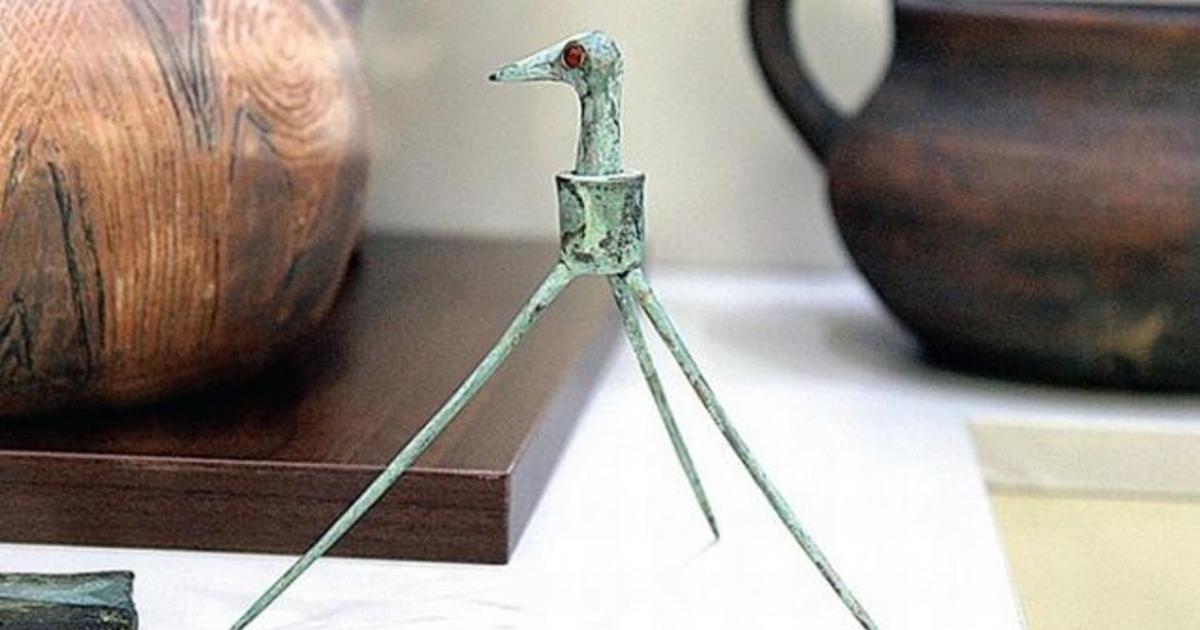
Bronze Age Thracian Stork may be Oldest Children's Toy in Europe
Local residents in the area of Zlatograd, Bulgaria, have uncovered an ancient bronze artifact that archaeologists have described as “the oldest children’s toy in Europe”. The supposed toy consists of a moveable stork’s head, with eyes made from semi-precious stones, on a tripod stand.
According to the website Archaeology in Bulgaria, the alleged toy dates back to around 1500-1200BC, a time when the Thracians, an ethno-cultural group of Indo-European tribes, were inhabiting the Balkan Peninsula. It was found, along with other archaeological artifacts, by locals near the town of Yagnevo, Zlatograd in the Rhodope Mountains, an area in which a number of Thracian sanctuaries and rock tombs have been discovered.
- The Enigma of the Thracians and the Orpheus Myth
- Temple in ancient city of Odessus reveals Greek Goddess Aphrodite was worshipped by Thracians
- Bulgarian Archaeologists find Evidence of 2,700-Year-Old Thracian Child Sacrifice

The artifact was discovered in a town located in the Rhodope Mountains (pictured), Bulgaria (Wikimedia Commons)
“Bulgarian scholars, including Assoc. Prof. Krasimir Leshtakov who teaches prehistory and archaeology at Sofia University “St. Kliment Ohridski”, believe that the artifact is the only children’s toy found the Late Bronze age found so far, and the oldest known children’s toy in Europe,” reports Archaeology in Bulgaria.
The construction of toys is believed to date back to Pleistocene era, with some archaeologists even suggesting hominids were making stone toys from as early as 2 million years ago. In April, 2014 another study published in the Oxford Journal of Archaeology revealed evidence that Neanderthal children played with toy axes and were taught how to make tools. Both claims have been hotly debated.
More concrete evidence of toy construction has been found in Egypt dating back to around 3000 BC. Children in ancient Egypt played with dolls that had wigs, faces, and movable limbs. They also played with jointed animal toys carved from ivory, wood, bone, ceramic, or stone. Later, ancient Greek children played with “puzzles” that were made up of 12 or 14 squares, which could be arranged into different shapes.
- Archaeologists uncover 2,500-year-old baby grave containing a toy rattle
- New research suggests Neanderthal children played with toy axes
- Archaeologists discover 2,400-year-old Terracotta Baby Bottle
- Archaeologists in China claim to have found two million-year-old stone toys

Ancient toy: Ceramic rattle in the shape of a pig, Cypro-Archaic II period (600-480BC). (Wikimedia Commons)
While a number of archaeologists in Bulgaria have hailed the stork as the oldest toy in Europe, not everyone is convinced. Archaeologists Nikolay Ovcharov suggests the bronze stork may not be a toy at all, but rather a religious icon.
“The so called toy is so called because experts on the Bronze Age cannot figure out what [else] it could have been because no such artifact has ever been discovered in the world,” Professor Ovcharov explained, as cited by the Bulgarian National Radio. “It is hard to say what exactly it was used for. It may have been a regular children’s toy but it is also quite possible that this item had some kind of a function in the religious practices of the Ancient Thracians, for example, with clairvoyance. However, we have no way of knowing much about that because this period, the second millennium BC, was a time devoid of the written word,” he added.
Further archaeological excavations are planned in the Rhodope Mountains in the summer of this year. It is hoped that further discoveries will shed more light on the Thracians, their beliefs, practices, and way of life.
Featured image: Ancient bronze stork discovered in the Rhodope Mountains in Southern Bulgaria. Photo: TV grab from BNT.
















Comments
What about the famous wheeled model of an auroch or ox from the Danube Valley civilization. This is almost certainly a childs' toy and dates from no later than 3500BCE making it at least 2000 years older than the stork.
My first reaction too was this was a map marker. Though archeologists are never going to give the Thracians credit for making and using maps when there is no evidence they even had a written language... Yet, here they are, able to make a toy/cult object - not only from bronze but with some silver inlay and a semi-precious stones for eyes - that comes complete with bobbing head. There has to be a reason to give this object three distinct pointed tripod feet - a novelty stork could have simply been constructed as a simple stork on one or two legs with wings surely?
Heatherj, thank you for chrystalising my thoughts into words, regarding the “experts”. Yes it is nearly always religion when they are hopelessly lost for an explanation. Irritating.
I was thinking of a surveying tool. But our minds went in the same general direction. I don't know why "experts" always jump to religion (or toys) when they don't know what something is. I have several objects around my house that serve no other purpose except for the fact that I like them and think they look neat. I doubt anyone living thousands of years ago was any different.
It is not a toy and if it were in my childhood then I would have been blind and full of holes from my two brothers, playing with it, who were older than I. I will hazard an educated guess and say that it is a map marker, similar to a pair of compasses but with three legs for cross referencing similar to that which we employe today with 3 GPS satelites. The protruding beak is there to enable a swivelling motion with ones finger and thumb whilst hovering over the map.